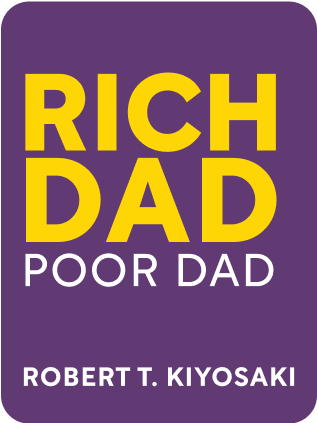

This article is an excerpt from the Shortform summary of "Rich Dad Poor Dad" by Robert T. Kiyosaki. Shortform has the world's best summaries of books you should be reading.
Like this article? Sign up for a free trial here .
What does it mean to work to learn? Is there a point of working jsut to learn?
Work to Learn is a principle in Rich Dad, Poor Dad that explains that there might be more to working than making money. Work to Learn can help you achieve financial independence.
Work to Learn: Learning with Rich Dad
Spread across a few chapters in Rich Dad, Poor Dad, the author narrates his experience with Rich Dad learning the principles of money and work.
Learning the First Lesson
As a 9 year old, Robert Kiyosaki is rejected socially by the rich kids in his public school. He asks his dad, a teacher, how to get rich and make money, but his dad has no satisfactory answer.
He commiserates with his best friend Mike, the only other non-visibly-wealthy kid in the school. They start a misguided idea to melt down metal toothpaste tubes and mint their own nickels. Bemused, Robert’s dad (Poor Dad) suggests they talk to Mike’s dad (Rich Dad), who owns multiple local businesses and seems to be on a good path.
- Poor Dad also notes that the other apparently rich kids have parents who are just like him – they’re employed by the local plantation, and if the company gets into trouble, they’ll soon have nothing. Rich Dad is different since he seems to be paving his own way.
Rich Dad is busy, but meets with them early in the morning between his regular business meetings with his managers. Rich Dad has this dialogue:
- “Here’s my offer. I’ll teach you, but not like a teacher in a classroom. Work for me, and I’ll teach you. Don’t work for me, and I won’t teach you. You’ll learn faster if you work. That’s my offer. Take it or leave it.”
- “Can I ask a question first?” Kiyosaki asks.
- “No. Take it or leave it. I’m too busy to waste my time. If you can’t be decisive and make up your mind quickly, you’ll never learn to make money. Opportunities come quickly and go quickly. You need to know when to make fast decisions. I just gave you an opportunity that you asked for. Will you take it?”
They take the deal, which means working for 10 cents an hour in Rich Dad’s convenience store. They know this is an unfair wage. But this is an introduction to the concept work to learn.
After laboring for 3 hours over 3 weekends, Robert Kiyosaki gets upset and wants to quit. His friend is amused, since Rich Dad expected he’d want to quit, and wanted to meet afterward.
Before the meeting, Poor Dad advises the author to demand what he deserved – at least 25 cents an hour. If he doesn’t get the raise, Poor Dad counsels, Robert Kiyosaki should quit immediately.
Kiyosaki takes Poor Dad’s advice, and starts the meeting demanding more money, demanding to be treated better, threatening child labor lawsuits, and complaining the Rich Dad hasn’t taught him anything. Rich Dad replies: “Not bad. In less than a month, you sound like most of my employees.”
Rich Dad’s point of the exercise is this:
- Most people accept jobs with lower pay than they deserve out of fear – fear of not paying their bills, of being fired, of not having enough money, of starting over. Fear governs their emotions around money, and they become a slave to working to make money.
- Life pushes everyone around. Many people quit and let the pushing happen. Some get angry and push back, but in the wrong direction – against the boss, their job, their spouse, or the world. Others learn the lesson, try to get better, and move on.
- By getting angry, the author showed Rich Dad that he had enough passion and independence of mind to be worth teaching.
Rich Dad is pleased and says, “you boys are the first to come to me asking how to make money. Over 150 employees work in my companies, and not a single one has come to me to learn about money. They ask for a job or a bigger paycheck, but never to educate themselves about money. So they’ll spend their lives working for money, but not actually understanding it.”
Work to Learn, Not for Pay
This is the idea behind work to learn. Rich Dad’s next order is for the author and Mike to go back working, but now with zero pay. When Kiyosaki complains, Rich Dad challenges him: we can go back to our original deal of 10 cents, or you can do what most people do – complain there isn’t enough pay, and go looking for another job. When Kiyosaki is confused, Rich Dad advises him to use his head.
After working for 3 more weeks, both kids are confused by what they’re supposed to be learning. Rich Dad comes by and tells them there’s a lesson to be learned here.
“If you don’t learn this lesson, you’ll end up like other people who work hard, clinging to their pay and constantly looking forward for their vacation days and little raises. Here – I’ll raise your pay to 25 cents an hour. Does that excite you? Do you want to take it?”
Rich Dad keeps raising the stakes – a dollar an hour. $2 an hour. The author’s imagination runs wild at having that much money, but he knows he’s being tested. Each person has a weak and needy part of their soul that can be bought. Each person also has a part of their soul that is strong and can never be bought.
The point of the lesson: most people run endlessly in a loop between fear and greed.
- Fear of not having money makes people work hard.
- Then once they get a paycheck, greed gets them salivating over all the things money can buy. They spend the money thinking it can buy joy, but the joy is short-lived. Soon they have money problems, and fear drives back in.
- This cycles endlessly, even as their paycheck increases – this is the Rat Race. Money ends up running their lives.
- Even rich people are subject to this fear – the more money they get, the more terrified they are of losing it. They fear losing social standing, and the weak part of their soul gets even more desperate.
Rich Dad was trying to teach the kids not to give into emotions around money, but rather to delay reactions and think. This is how you work to learn.
- Taking on the job for free was the first resistance to emotions.
- Next, raising the hourly wage for the kids was a metaphor for adult salaries. Incremental raises trigger hopes for incremental advancements to life, causing people to live in a perpetual loop and never truly exploring their dreams.
The Breakthrough
Rich Dad leaves with this advice: “The sooner you stop thinking you need a paycheck, the easier your adult life will be. Keep learning, keep using your brain, keep working for free, and your mind will make you more money far beyond what I could afford to pay you. You will see opportunities right under your nose that other people choose not to see. They’re blind to these opportunities because they look anxiously for money and security.”
After a few more weeks of working for free, one day Kiyosaki has an insight – the store he worked in regularly disposed of its comic books. Could they collect the books, then start a comic book library open to the public? They could charge other kids 10 cents admission for unlimited reading – a clear bargain, since a comic costs 10 cents each.
After some work, they launch with great success. They earn $9 per week over 3 months. They pay Mike’s sister $1 a week for managing the store.
After three months, bullies break into the room, and Rich Dad suggests they shut down the business. But the lesson was learned: by not being paid, they were forced to find opportunities to make money. They avoided being distracted by the short-term carrot.
Work to Learn can help you find purpose in work, and learn about finance and other businesses you may be interested in. You can always work to learn no matter where you are in life.

———End of Preview———
Like what you just read? Read the rest of the world's best summary of Robert T. Kiyosaki's "Rich Dad Poor Dad" at Shortform .
Here's what you'll find in our full Rich Dad Poor Dad summary :
- The key differences in how rich dad and poor dad approached life
- Why it's a terrible idea to buy an expensive house
- How to overcome your own mental blocks to become wealthy for life






